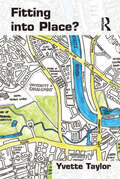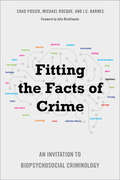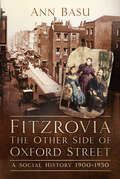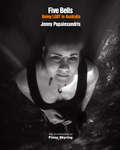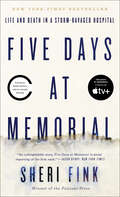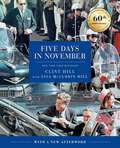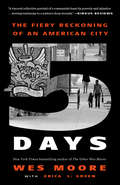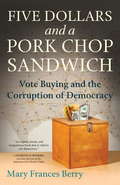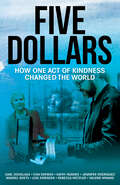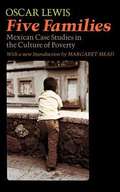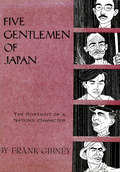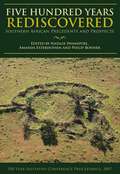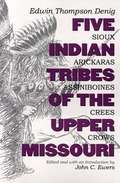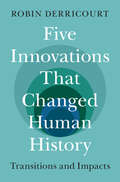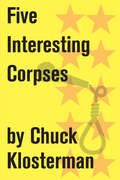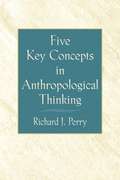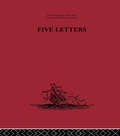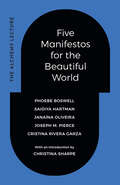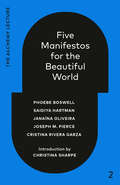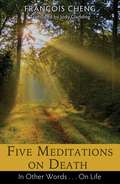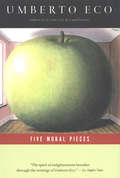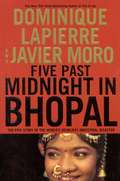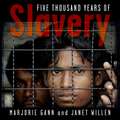- Table View
- List View
Fitting into Place?: Class and Gender Geographies and Temporalities
by Yvette TaylorFitting into Place adopts a multi-dimensional interdisciplinary approach to explore shifting geographies and temporalities that re-constitute 'city publics' - and the place of the 'public sociologist'. Class, race and gender (dis)advantages are situated in relation to urban-rural contrasts, where 'future selves' are reconfigured in and through 'local' and 'global' sites: people inhabit shifting times and places, from industrial landscapes of the 'past', to a current present and (imagined) 'cosmopolitan' 'regenerated' future. The rhetorics and vocabularies of place, as affective and material, suggest a more complex 'fit' than the language of masculine 'crisis' for past-times, or 'feminised' fit into new-futures, suggests. Across the generations, women's labour is still effaced as maps of loyalty hold up families as reference points of belonging and 'fitting in'; such architecture of place complicates reified 'geographies of choice' which centre a middle-class mobile subject. Based upon funded empirical research, this book will be of interest to sociologists and geographers.
Fitting the Facts of Crime: An Invitation to Biopsychosocial Criminology
by Chad Posick Michael Rocque J.C. BarnesBiosocial criminology—and biosocial criminologists—focuses on both the environmental and biological factors that contribute to antisocial behavior. Importantly, these two domains are not separate parts of an equation but pieces of the same puzzle that fit together for a complete picture of the causes of crime/antisocial behavior. Fitting the Facts of Crime applies a biopsychosocial lens to the “13 facts of crime” identified by John Braithwaite in his classic book, Crime, Shame and Reintegration. The authors unpack established facts—about gender and sex, age, environment, education, class, social bonds and associations, stress, and other influences—providing both empirical research and evidence from biopsychosocial criminology to address the etiology behind these facts and exactly how they are related to deviant behavior. With their approach, the authors show how biopsychosocial criminology can be a unifying framework to enrich our understanding of the most robust and well-established topics in the field. In so doing, they demonstrate how biological and psychological findings can be responsibly combined with social theories to lend new insight into existing inquiries and solutions. Designed to become a standard text for criminology in general, Fitting the Facts of Crime introduces key concepts and applies them to real-world situations.
Fitzrovia, The Other Side of Oxford Street: A Social History 1900-1950
by Ann BasuThis is the other side of the story. Before the Second World War, Ann Basu’s family of Jewish tailors lived where the BT Tower stands today. At that time of high migration, the women’s fashion trade and the new car industry were sweeping into Fitzrovia, Russian and German anarchists argued in its clubs, Indian revolutionaries practised at the shooting range, and popular cafes such as Lyons’ transformed the social lives of workers. The Jews of Fitzrovia and Soho saw each other as being on the ‘other side’ of Oxford Street, and this book reflects Fitzrovia’s distinctive ‘inbetween-ness’ – at the inner edge of central London, but separate from the West End. Putting the spotlight on Fitzrovia’s enterprising twentieth-century immigrant workers, this is the history of working-class and outsider voices that have previously been muted
Five Bells
by Jenny Papalexandris Fiona SkyringIn a country known as one of the most queer-friendly nations in the world, most Australians support LGBTI rights, federal laws protect queer people from discrimination, transgender Australians are recognized legally as their preferred gender, and the renown of Sydney's Gay and Lesbian Mardi Gras Festival has reached across its borders.The eight visual narratives that make up award-winning Australian photographer Jenny Papalexandris's intimate and thematically rich Five Bells offers a celebration of queer life, giving the reader a visual portrait of everyday life among queer-identifying people, from joyful images of weddings and family gatherings to more contemplative portraits of rural youth and asylum seekers. In so doing, the book presents a series of neither caricatures nor stereotypes but of individuals-active agents in the universal quest for happiness, intimacy, fulfillment, respect, and a sense of belonging. This is the human face of the queer community in Australia, and these beautifully crafted and life-affirming photographs, in black-and-white and in color, show us the personal and psychological landscape of what it means to be part of a community that is as vibrant as it is diverse.
Five Days at Memorial: Life and Death in a Storm-Ravaged Hospital
by Sheri FinkOne of the New York Times's Best Ten Books of the YearWinner of the National Book Critics Circle Award for NonfictionWinner of the 2014 J. Anthony Lukas Book Prize, the PEN/John Kenneth Galbraith Award, the Los Angeles Times Book Prize, the Ridenhour Book Prize, the 2014 American Medical Writers Association Medical Book Award (Public/Healthcare Consumers), a 2014 Science in Society Journalism Award, and the SIBA 2014 Book Award for NonfictionAn ALA Notable Book, finalist for the NYPL 2014 Helen Bernstein Award, shortlisted for the PEN/E.O. Wilson Award and the ALA Andrew Carnegie MedalAn NPR "Great Reads" Book, a Chicago Tribune Best Book, a Seattle Times Best Book, a Time Magazine Best Book, Entertainment Weekly's #1 Nonfiction Book, a Christian Science Monitor Best Book, and a Kansas City Star Best BookPulitzer Prize winner Sheri Fink's landmark investigation of patient deaths at a New Orleans hospital ravaged by Hurricane Katrina - and her suspenseful portrayal of the quest for truth and justice.In the tradition of the best investigative journalism, physician and reporter Sheri Fink reconstructs 5 days at Memorial Medical Center and draws the reader into the lives of those who struggled mightily to survive and to maintain life amid chaos.After Katrina struck and the floodwaters rose, the power failed, and the heat climbed, exhausted caregivers chose to designate certain patients last for rescue. Months later, several health professionals faced criminal allegations that they deliberately injected numerous patients with drugs to hasten their deaths. Five Days at Memorial, the culmination of six years of reporting, unspools the mystery of what happened in those days, bringing the reader into a hospital fighting for its life and into a conversation about the most terrifying form of health care rationing.In a voice at once involving and fair, masterful and intimate, Fink exposes the hidden dilemmas of end-of-life care and reveals just how ill-prepared we are in America for the impact of large-scale disasters--and how we can do better. A remarkable book, engrossing from start to finish, Five Days at Memorial radically transforms your understanding of human nature in crisis.
Five Days at Memorial: Life and Death in a Storm-Ravaged Hospital
by Sheri FinkPulitzer Prize winner Sheri Fink's landmark investigation of patient deaths at a New Orleans hospital ravaged by Hurricane Katrina - and her suspenseful portrayal of the quest for truth and justice. <P><P>In the tradition of the best investigative journalism, physician and reporter Sheri Fink reconstructs 5 days at Memorial Medical Center and draws the reader into the lives of those who struggled mightily to survive and to maintain life amid chaos. <P> After Katrina struck and the floodwaters rose, the power failed, and the heat climbed, exhausted caregivers chose to designate certain patients last for rescue. <P>Months later, several health professionals faced criminal allegations that they deliberately injected numerous patients with drugs to hasten their deaths. <P>Five Days at Memorial, the culmination of six years of reporting, unspools the mystery of what happened in those days, bringing the reader into a hospital fighting for its life and into a conversation about the most terrifying form of health care rationing. <P>In a voice at once involving and fair, masterful and intimate, Fink exposes the hidden dilemmas of end-of-life care and reveals just how ill-prepared we are in America for the impact of large-scale disasters--and how we can do better. <P> A remarkable book, engrossing from start to finish, Five Days at Memorial radically transforms your understanding of human nature in crisis.
Five Days in November
by Clint Hill Lisa McCubbin HillSecret Service agent Clint Hill reveals the stories behind the iconic images of the five tragic days surrounding President John F. Kennedy&’s assassination in this 60th anniversary edition of the New York Times bestseller.On November 22, 1963, three shots were fired in Dallas, President John F. Kennedy was assassinated, and the world stopped for four days. For an entire generation, it was the end of an age of innocence. That evening, a photo ran on the front pages of newspapers across the world, showing a Secret Service agent jumping on the back of the presidential limousine in a desperate attempt to protect the President and Mrs. Kennedy. That agent was Clint Hill. Now Hill commemorates the sixtieth anniversary of the tragedy with this stunning book containing more than 150 photos, each accompanied by his incomparable insider account of those terrible days. A story that has taken Hill half a century to tell, this is a &“riveting, stunning narrative&” (Herald & Review, Illinois) of personal and historical scope. Besides the unbearable grief of a nation and the monumental consequences of the event, the death of JFK was a personal blow to a man sworn to protect the first family, and who knew, from the moment the shots rang out in Dallas, that nothing would ever be the same.
Five Days: The Fiery Reckoning of an American City
by Wes Moore Erica L. GreenFrom the New York Times bestselling author of The Other Wes Moore, a kaleidoscopic account of five days in the life of a city on the edge, told through eight characters on the front lines of the uprising that overtook Baltimore and riveted the world When Freddie Gray was arrested for possessing an “illegal knife” in April 2015, he was, by eyewitness accounts that video evidence later confirmed, treated “roughly” as police loaded him into a vehicle. <P><P>By the end of his trip in the police van, Gray was in a coma from which he would never recover. In the wake of a long history of police abuse in Baltimore, this killing felt like the final straw—it led to a week of protests, then five days described alternately as a riot or an uprising that set the entire city on edge and caught the nation's attention. Wes Moore is a Rhodes Scholar, bestselling author, decorated combat veteran, former White House fellow, and CEO of Robin Hood, one of the largest anti-poverty nonprofits in the nation. <P><P>While attending Gray’s funeral, he saw every stratum of the city come together: grieving mothers, members of the city’s wealthy elite, activists, and the long-suffering citizens of Baltimore—all looking to comfort one another, but also looking for answers. He knew that when they left the church, these factions would spread out to their own corners, but that the answers they were all looking for could be found only in the city as a whole. <P><P>Moore—along with journalist Erica Green—tells the story of the Baltimore uprising both through his own observations and through the eyes of other Baltimoreans: Partee, a conflicted black captain of the Baltimore Police Department; Jenny, a young white public defender who&’s drawn into the violent center of the uprising herself; Tawanda, a young black woman who’d spent a lonely year protesting the killing of her own brother by police; and John Angelos, scion of the city’s most powerful family and executive vice president of the Baltimore Orioles, who had to make choices of conscience he’d never before confronted. <P><P>Each shifting point of view contributes to an engrossing, cacophonous account of one of the most consequential moments in our recent history, which is also an essential cri de coeur about the deeper causes of the violence and the small seeds of hope planted in its aftermath.
Five Dollars and a Pork Chop Sandwich
by Mary Framces BerryA timely and nonpartisan book on voter manipulation and electoral corruption--and the importance of stimulating voter turnout and participationThough voting rights are fundamental to American democracy, felon disfranchisement, voter identification laws, and hard-to-access polling locations with limited hours are a few of the ways voter turnout is suppressed. These methods of voter suppression are pernicious, but in Five Dollars and a Pork Chop Sandwich, Dr. Mary Frances Berry focuses on forms of corruption including vote buying, vote hauling, the abuse of absentee ballots, and other illegal practices by candidates and their middlemen, often in collusion with local election officials.Vote buying--whether it's for a few dollars, a beer, or a pack of cigarettes--is offered to individual citizens in order to ensure votes for a particular candidate, and Dr. Berry notes it occurs across party lines, with Republicans, Democrats, and independents all participating.Dr. Berry shares the compelling story of Greg Malveaux, former director of Louisiana's Vote Fraud Division, and how this "everyman" tried to clean up elections in a state notorious for corruption. Malveaux discovered virtually every type of electoral fraud during his tenure and saw firsthand how abuses occurred in local communities--from city councils to coroners' offices. In spite of Sisyphean persistence, he found it virtually impossible to challenge the status quo. Dr. Berry reveals how this type of electoral abuse is rampant across the country and includes myriad examples from other states, including Illinois, Texas, Florida, Kentucky, and Mississippi.Voter manipulation is rarely exposed and may be perceived as relatively innocuous, however; Dr. Berry observes that in addition to undermining basic democracy, it also leads to a profound lack of accountability and a total disconnect between politicians and their constituents, and that those in poor and minority communities are the most vulnerable. While reforming campaign finance laws are undeniably important to our democracy, being attuned to issues of structural powerlessness and poverty, and to the cycles that perpetuate them, is no less crucial.In Five Dollars and a Pork Chop Sandwich, Dr. Berry shares specific successful voting strategies that other countries have adopted and urges creativity in rewarding people for voting. She also underscores the continued importance of grassroots education, so that citizens see voting as desirable and empowering--as a tool to help create the kind of environment they deserve.From the Hardcover edition.
Five Dollars: How One Act of Kindness Changed the World
by Eight AuthorsDiscover the transformative power of a single act of kindness in Five Dollars: How One Act of Kindness Changed the World. This heartwarming and inspiring novel follows the remarkable journey of a five-dollar bill as it travels through the hands of diverse individuals, sparking a global movement of generosity and compassion. From a struggling family man and a devoted parishioner to a reformed criminal and an elderly woman finding new purpose, each character's story weaves into a tapestry of interconnected lives. As small acts of kindness ripple outwards, they create profound change in communities, overcoming skepticism, resistance, and even corruption. Five Dollars is a testament to the enduring impact of human kindness and a powerful reminder that even the smallest gestures can unite us, transform lives, and create a brighter, more compassionate world. Join this extraordinary journey and be inspired to believe in the boundless potential of goodwill and the remarkable difference each of us can make.
Five Families: Mexican Case Studies in the Culture of Poverty
by Oscar LewisThis book is a dramatic and forceful account of the men, women, and children of five Mexican families and the impoverished communities in which they live.
Five Gentlemen of Japan
by Frank GibneyA newspaperman, an ex-Navy vice-admiral, a steel worker, a farmer, and the 124th Emperor of Japan himself-these are the fascinating heroes of Gibney's brilliant book about modern Japan. Strongly individual, everyone of them, the five yet share the common inheritance of Japan's precocious but unstable past.Through their lives and attitudes, Gibney gives us an invaluable analysis of this new sovereign nation so suddenly thrown into the world's power conflicts. He helps us understand the historical and social forces which make Japan what she is today-the old contracts and loyalties from which each of the Five Gentlemen is struggling to free himself and his country. Their courageous efforts to weld a new Japan from the remains of the old society, and to come to terms with the present, is as exciting as it is important. For, should they succeed, great hope for the free world lies in their success.
Five Hundred Years Rediscovered: Southern African precedents and prospects
by Natalie Swanepoel, Amanda Esterhuysen and Philip BonnerIn the age of the African Renaissance, southern Africa has needed to reinterpret the past in fresh and more appropriate ways. The last 500 years represent a strikingly unexplored and misrepresented period which remains disfigured by colonial/apartheid assumptions, most notably in the way that African societies are depicted as fixed, passive, isolated, un-enterprising and unenlightened. This period is one the most formative in relation to southern Africa’s past while remaining, in many ways, the least known. Key cultural contours of the sub-continent took shape, while in a jagged and uneven fashion some of the features of modern identities emerged. Enormous internal economic innovation and political experimentation was taking place at the same time as expanding European mercantile forces started to press upon southern African shores and its hinterlands. This suggests that interaction, flux and mixing were a strong feature of the period, rather than the homogeneity and fixity proposed in standard historical and archaeological writings. Five Hundred Years Rediscovered represents the first step, taken by a group of archaeologists and historians, to collectively reframe, revitalise and re-examine the last 500 years. By integrating research and developing trans-frontier research networks, the group hopes to challenge thinking about the region’s expanding internal and colonial frontiers, and to broaden current perceptions about southern Africa’s colonial past.
Five Indian Tribes of the Upper Missouri: Sioux, Arickaras, Assiniboines, Crees and Crows
by Edwin Thompson Denig John C. EwersDenig assisted Audubon and the Culbertsons in collecting Missouri River fauna, supplied information on the Indians to Father De Smet, who encouraged him to write, and provided Henry Schoolcraft with an Assiniboine vocabulary as well as a detailed "Report on the Indian Tribes of the Upper Missouri," which was not published until 1930, seventy-six years after it was written, and then only in parts. Denig's writings on the Sioux, Arickaras, Assiniboines, Crees, and Crows, comprising the Denig manuscript in the Missouri Historical Society, are published together for the first time in this book. The manuscript long had been referred to as the "Culbertson Manuscript" because it had been purchased from a descendant of the fur-trader naturalist Alexander Culbertson. But in 1949, handwriting experts identified it as the work of Denig.
Five Innovations That Changed Human History: Transitions and Impacts
by Robin DerricourtWe live in an era of major technological developments, post-pandemic social adjustment, and dramatic climate change arising from human activity. Considering these phenomena within the long span of human history, we might ask: which innovations brought about truly significant and long-lasting transformations? Drawing on both historical sources and archaeological discoveries, Robin Derricourt explores the origins and earliest development of five major achievements in our deep history, and their impacts on multiple aspects of human lives. The topics presented are the taming and control of fire, the domestication of the horse,and its later association with the wheeled vehicle, the invention of writing in early civilisations, the creation of the printing press and the printed book, and the revolution of wireless communication with the harnessing of radio waves. Written in an engaging and accessible style, Derricourt's survey of key innovations makes us consider what we mean by long-term change, and how the modern world fits into the human story.
Five Interesting Corpses
by Chuck KlostermanOriginally collected in Chuck Klosterman IV and now available both as a stand-alone essay and in the ebook collection Chuck Klosterman on Media and Culture, this essay is about dead people.
Five Key Concepts in Anthropological Thinking
by Richard J. PerryThis highly readable introduction discusses anthropological theory in a manner accessible to lay readers, yet does not oversimplify the material. Addresses five key concepts--evolution, culture, structure, function, and relativism--rather than individual theorists, and conveys the sense that their theory and associated debates can be interesting despite their complexity. Presents a balanced view of varying theoretical positions to pique readers' interest and avoid confusion. Uses clear, straightforward language, avoiding esoteric jargon. Critiques certain theoretical positions, including 19th-century racist theories and contemporary post-structural and postmodernist approaches. Includes a glossary of key terms that are highlighted throughout. A thought-provoking reference for anyone interested in learning about anthropology.
Five Letters 1519-1526
by Hernando CortésFirst published in 1928.'These letters, well edited tell of a great conqueror, fighting for God and his king, and reveal the might proportions of the truly Elizabethan character that was Hernando Cortés.' Times Literary Supplement.Cortés's letters to the Emperor from Mexico are half-letters, half-despatches. The letters were all written between 1519 and 1526.Letter One: Despite the original never having been recovered, there is little doubt about the contents of this letter. The earliest discoveries of the mainland from 1517 onwards are outlined.Letter Two: Arguably the most dramatic of the five, this letter opens with the advance into the heart of the hostile country and the capture of the monarch.Letter Three: This letter covers the advance of Cortés into Culua, the assault on the capital itself and the various enterprises undertaken by the Conqueror to extend his power throughout Mexico.Letter Four: This letter is mainly concerned with organizational affairs, with the visit of Garay, causing rebellion in Pánuco, and concluding with the Frenchman's death, being the most important incident.Letter Five: Beginning with the start of the expedition to Honduras, and chronicling the trials and tribulations of the daring journey, this letter ends with an account of Cortés' triumphant return to the post of Governor after several years' absence.
Five Manifestos for the Beautiful World: The Alchemy Lecture
by Saidiya Hartman Cristina Rivera Garza Joseph M. Pierce Phoebe Boswell Janaína OliveiraThe second annual Alchemy Lecture brought together five artists, thinkers, and writers who proposed new ways of being and discussed radical visions for the future. Five Manifestos for the Beautiful World captures and expands these lectures to illuminate our path toward this possible beautiful world. Joseph M. Pierce (Cherokee Nation) asserts that “for this decolonial future to become possible, the guiding force must no longer be capital but relations.” Film curator Janaína Oliveira (Brazil) evokes music and movement as a means toward this relationality. Visual artist Phoebe Boswell (UK/Kenya) asks, “If we burn down the institution, what happens next?” Saidiya Hartman (US) prompts us to consider our capacity to burn, examining whether “the gift of pragmatism yields a profound tolerance of the unlivable.” Cristina Rivera Garza (US/Mexico) gives us the language of the future in the subjunctive, “the smuggler who crosses the border of the future bearing unknown cargo.” Each alchemist is intimately concerned with this cargo, our ability to bear its weight, and how we might find the beautiful world together.
Five Manifestos for the Beautiful World: The Alchemy Lecture 2023 (The Alchemy Lecture)
by Saidiya Hartman Cristina Rivera Garza Joseph M. Pierce Phoebe Boswell Janaína OliveiraFive Alchemists. One book. A constellation of ideas.The second annual Alchemy Lecture was presented in November 2023 at York University to a sold out in-person audience and nearly one thousand live online viewers. Moderated by Dr. Christina Sharpe, the Alchemists—agile thinkers and practitioners working across a range of disciplines and geographies—convened to discuss their radical visions of the beautiful world, and the manifestos that may help to guide us there. Their treatises have been captured and luminously expanded in the pages of this book.Cherokee Nation citizen and professor Joseph M. Pierce asserts that &“[f]or this decolonial future to become possible, the guiding force must no longer be capital but relations.&” Informed by her practice of &“curation as care,&” Brazilian film curator Janaína Oliveira evokes music and movement as a means toward this relationality: &“it's almost by falling that you live. . . . The beautiful world dances the stumbles. The beautiful world dances dancing.&” Kenyan-British visual artist Phoebe Boswell uses the space of a virtual gallery to ask, &“If we burn down the institution, what happens next? Do we trust ourselves to know?&” and gestures toward the possibility of this &“as yet unlived, unexperienced thing.&” Professor and MacArthur fellow Saidiya Hartman asks us to consider our capacity to burn, stating that &“[P]ragmatism yields a profound tolerance of the unlivable.&” And Mexican-American author Cristina Rivera Garza gives us the language of the future in the subjunctive, which &“lays the groundwork for the irruption. . . . The subjunctive is the smuggler who crosses the border of the future bearing unknown cargo.&”Each Alchemist is intimately concerned with the shape of this cargo and our ability to bear its weight, together. Through these expansive, transformative essays, new ways of being are threaded and proposed, illuminating our path towards this possible beautiful world.
Five Meditations on Death: In Other Words . . . On Life
by Jody Gladding François ChengPhilosophical discussions on the ways that death makes life meaningful and sacred• Reveals how being conscious of death gives our fate its full meaning, inviting the reader to contemplate life in the light of their own death• Examines the author’s experience of ancestor worship in his native China and the beliefs that underlie it• Explains how death is a transition in a longer living process not visible from the modern “black and white” view of life and death• Translated by award-winning translator Jody GladdingBorn from intimate discussions with friends, these five meditations on death from poet-philosopher François Cheng examine the multiple ways the prospect of death significantly shapes life and is, in fact, what makes life meaningful and sacred.Written at the age of 84, in the twilight of life, these meditations each approach the human understanding of death from different yet intertwined perspectives, effortlessly returning to certain themes and ideas, questioning them again more deeply with each passing. The author shows that death is a transition in a longer living process not visible from the modern “black and white” view of life and death. He examines his experience of ancestor worship in his native China and the beliefs that underlies it: Our ancestors are alive in another form, that what is living can never die and what is dead has never lived. Cheng looks at the consequences of a world that has abandoned the sacred and avoids the mention of death, a world now blindly staggering through the chaos it has created, yet which can return to balance if we once again embrace the essential sacredness of life as well as death.Throughout these five heart-baring meditations, Cheng invites us to contemplate life in the light of our own death. He reveals that to be conscious of death gives our fate its full meaning. Our death is an integral part of our great adventure in becoming. For if birth is a seed, then death is the fruit--the final sacred product of a life well lived.
Five Moral Pieces
by Umberto EcoIn this prescient essay collection, the acclaimed author of Foucault&’s Pendulum examines the cultural trends and perils at the dawn of the 21st century.In the last decade of the 20th century, Umberto Eco saw an urgent need to embrace tolerance and multiculturalism in the face of our world&’s ever-increasing interconnectivity. At a talk delivered during the first Gulf War, he points out the absurdity of armed conflict in a globalized economy where the flow of information is unstoppable and the enemy is always behind the lines. Elsewhere, he questions the influence of the news media and identifies its contribution to our collective disillusionment with politics. In a deeply personal essay, Eco recalls his boyhood experience of Italy&’s liberation from fascism. He then analyzes the universal elements of fascism, including the &“cult of tradition&” and a &“suspicion of intellectual life.&” And finally, in an open letter to an Italian cardinal, Eco reflects on a question underlying all the reflections in the book: What does it mean to be moral or ethical when one doesn't believe in God?&“At just 111 pages, Five Moral Pieces packs a philosophical wallop surprising in such a slender book. Or maybe not so surprising. Eco's prose here is beautiful.&”—January Magazine
Five Past Midnight in Bhopal: The Epic Story Of The World's Deadliest Industrial Disaster
by Dominique Lapierre Javier MoroIt was five past midnight on 3 Dec. 1984 when a terrifying cloud of toxic gas escaped from an American pesticide plant in Bhopal, India. Killing 30,000 & injuring 500,000 more, it was the most murderous industrial disaster in history. This book puts faces to the masses that were killed or injured. Hundreds of characters, situations & adventures are telescoped in this fresco full of love, heroism, faith & hope. This is a real tragedy of crucial relevance to our times. And the people of Bhopal are still suffering, with 150,000 people chronically affected. No court of law has ever passed judgment on Union Carbide for the crime committed & Warren Anderson, its then chairman. ¿A beautifully written, moving account of the night that forever changed India.¿
Five Past Midnight in Bhopal: The Epic Story of the World's Deadliest Industrial Disaster
by Dominique Lapierre Javier MoroA gripping, kaleidoscopic account of a horrific industrial disaster that shook the world, from wold-renowned humanitarian and internationally bestselling author Dominique Lapierre.It was December 3, 1984. In the ancient city of Bhopal, a cloud of toxic gas escaped from an American pesticide plant, killing and injuring thousands of people. When the noxious clouds cleared, the worst industrial disaster in history had taken place. Now, Dominique Lapierre brings the hundreds of characters, conflicts, and adventures together in an unforgettable tale of love and hope. Readers will meet the poetry-loving factory worker who unleashes the apocalypse, the young Indian bride who was to be married that terrible night, and the doctors who died that night saving others.
Five Thousand Years of Slavery
by Janet Wilson Marjorie GannTraces the practice of slavery throughout the millennia, drawing on historical narratives, personal accounts, and visual sources to cover such examples as the ancient Sumerian practice of selling children into bondage and the oppression of Zanj salt marsh workers.
